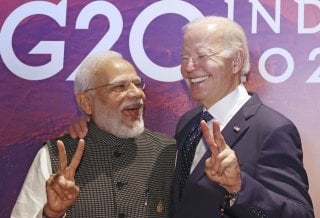Modi’s State Visit Was a Victory for the U.S.-India Partnership, but Ambiguities Remain
Envisioning the future relationship will require a willingness to overlook or manage differences without losing sight of shared interests.
Though the weather in the District of Columbia presented a gloomy and unusually chilly June day, the welcome for Indian prime minister Narendra Modi’s state visit was anything but. Though small groups of Sikh separatist activists and human rights protesters did appear near the White House, they were drowned out by the sizable and enthusiastic welcoming crowd of Indian-Americans assembled on the South Lawn.
The Biden administration hoped this week’s ceremonies would provide a stately capstone to over a decade of ever-closer strategic partnership between the United States and India. The hard work of cultivating New Delhi as an economic and security bulwark against China has paid off with a plethora of new joint initiatives. For Modi’s part, he successfully communicated India’s growing national and economic confidence and brushed off concerns about “democratic backsliding” by declaring that there is “no space for discrimination” in India.
The remarks from both Joe Biden and Narendra Modi following the prime minister’s welcome stressed shared, universal values, including democracy and pluralism. Ironically, the DC and New Delhi commentariat spent the last week debating the balance of hard interests that drive the “strategic partnership,” and wondering if “values” play any role at all.
Following a one-on-one conversation, Biden and Modi unveiled a number of advances in the U.S.-India strategic partnership across the board, from space exploration to semiconductors to supply chains to military cooperation. U.S. Navy vessels can obtain repairs in Chennai, Mumbai, and Goa. Both militaries will invite liaisons from each other officer corps—an outcome unthinkable during the distrust of the Cold War. Most importantly, India now has access to the coveted F414 jet engine through a coproduction agreement. Moreover, the leaders announced a $3 billion purchase of thirty MQ-9B Sea Guardian predator drones. Both deals will enhance Indian air strength and intelligence, surveillance, and reconnaissance capabilities vis-à-vis China in the Himalayas and the Indian Ocean.
Yet, developments in defense cooperation, while significant, must be seen as incremental improvements. Not only do they build on the achievements of the Trump and Obama administrations, but the fact will remain that India still relies on Russia for between 60 to 85 percent of its military equipment. While this critical dependence is lessening, it will not disappear for some time, and the rate of its diminishment depends on the United States offering cheaper defense weapons systems and India’s sustained investment in the modernization of its own armed forces.
As others have noted, Modi positioned India as a tribune for and bridge to the “Global South.” Biden seeks to take advantage of this by supporting India’s UN Security Council membership proposal and African Union representation at the G20. Realizing the noticeable lack of cooperation from developing countries on the administration’s Ukraine policy, the White House is eager to offer greater stakes in preserving the U.S.-led international order.
Modi’s address to a joint session of Congress attempted to soften his image with progressives and tout domestic achievements to Indian voters back home. Contrary to the media portrayal of the prime minister as a right-wing populist and analogue to Donald Trump, Modi waxed on the themes of diversity, dignity, and democracy while emphasizing his efforts to expand access to healthcare, protect the environment, and accelerate “women-led development.” Topped off with a thick layer of avuncular geniality, sprinkled with folksy Hindi witticisms, and encouraged by an enthusiastic visitor gallery, Modi’s address made a resoundingly charming impression on the assembled senators and members of Congress. That is apart from a group of hard-Left representatives that boycotted the speech.
Among the good feelings on either side and Modi’s talk of a “New Dawn,” those unfamiliar with the history of Indian grand strategy might be forgiven for thinking Washington and New Delhi will eventually agree to a treaty alliance akin to Australia or Japan. Nevertheless, India is certain to continue its hallowed policy of strategic autonomy and carve out a place for itself as one pole in a multipolar order. This carving, however, will no doubt rely on American military cooperation and economic investment, just as India’s non-alignment during the Cold War did not prohibit significant Soviet arms purchases.
Envisioning the future relationship will require a willingness to overlook or manage differences without losing sight of shared interests. India obviously cannot be classed among the United States’ traditional treaty allies. Yet it does not make sense that it be counted among more authoritarian partners with fewer shared values, like Saudi Arabia or Egypt. The fact that the United States and India at least conceive of themselves as quintessential democracies is significant, even if they disagree over the meaning as such.
James Himberger is the Associate Editor of The National Interest. He can be followed at @Beaconsfieldist on Twitter.
Image: Shutterstock.

